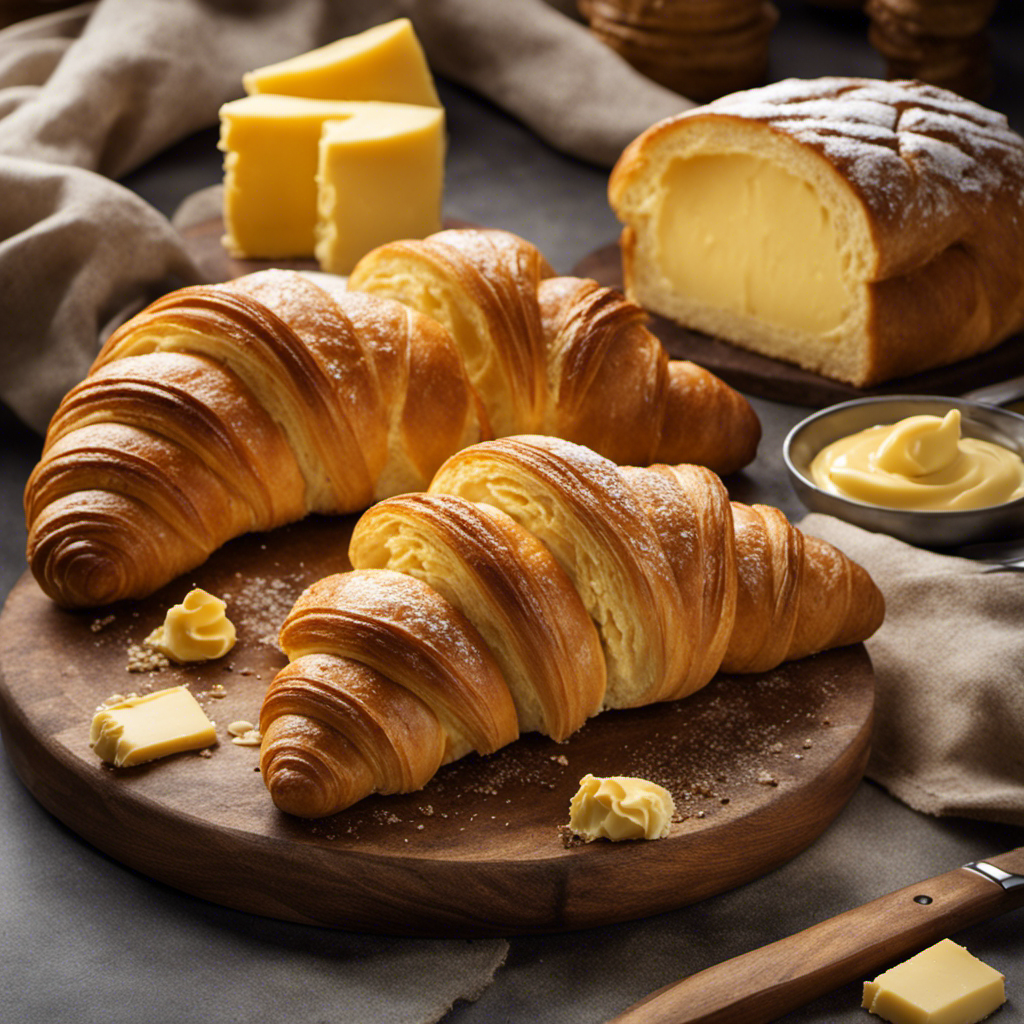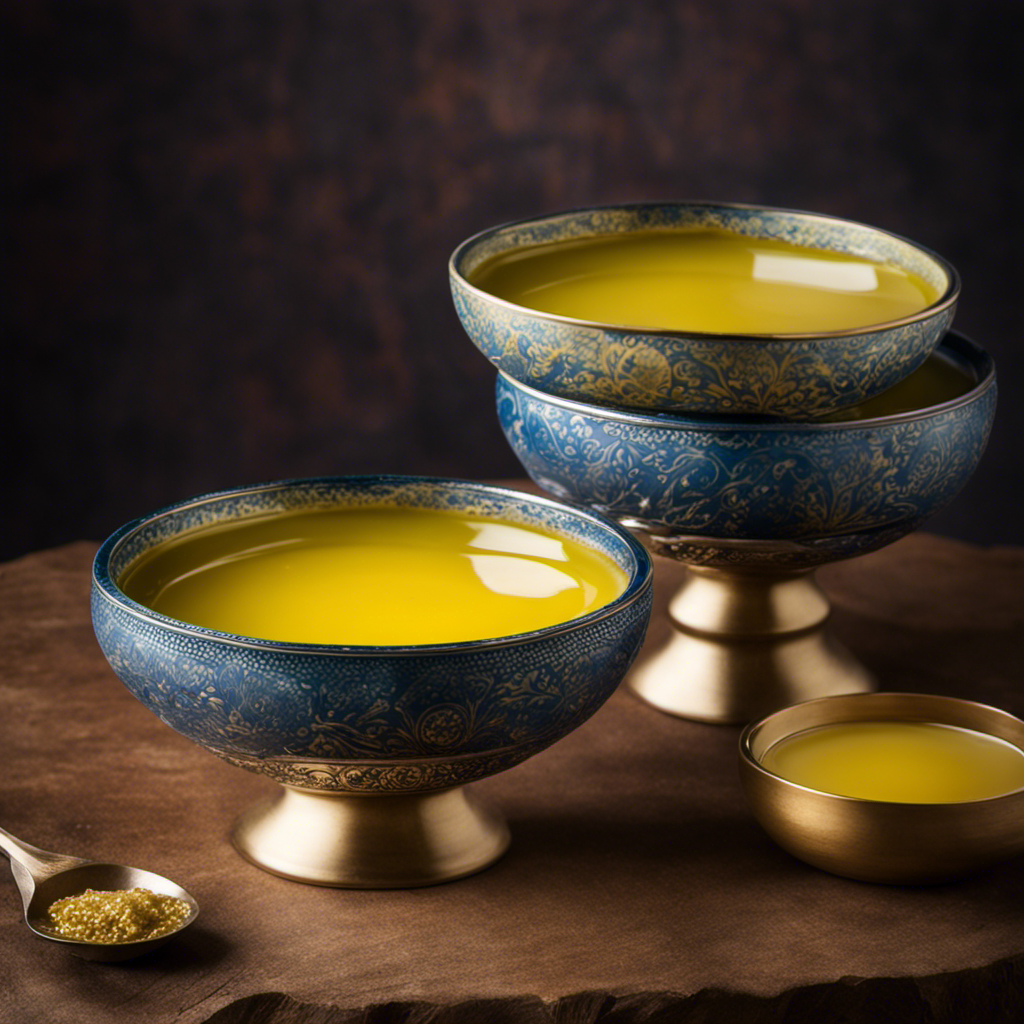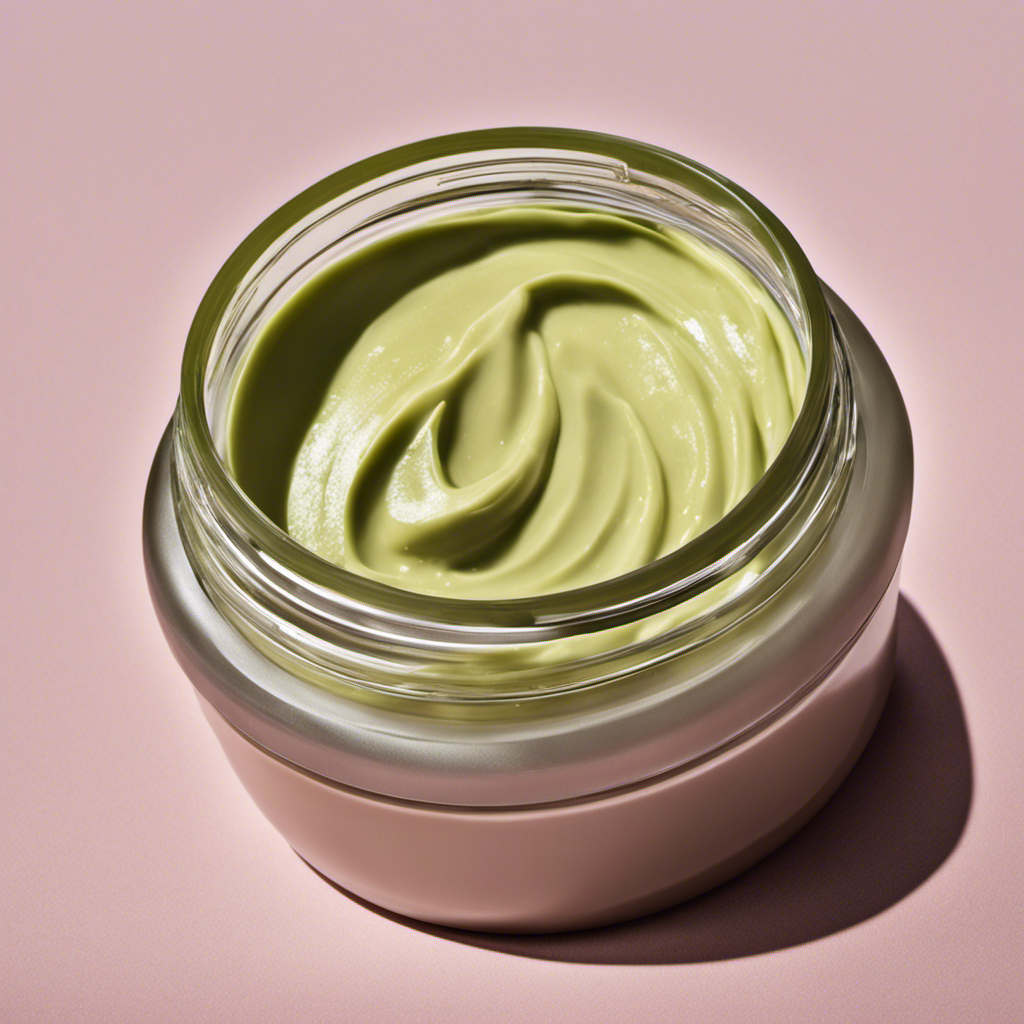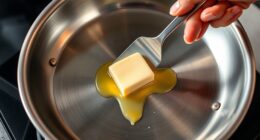I have always been fascinated by the wide variety of butter options available in the market. After conducting thorough research and taste tests, I am confident in stating that I have found the ultimate winner in the search for the best butter.
In this article, I’ll delve into the different types of butter, factors to consider when choosing, and even discuss the ongoing debate of butter versus margarine.
Get ready to discover the health benefits, explore organic and European butter, and learn about vegan alternatives. Plus, I’ll share tips on how to store butter for maximum freshness.
Let’s dive into the buttery world and find out what truly makes the best butter.
Key Takeaways
- Grass-fed butter is a good choice for higher omega-3 fatty acids.
- European-style butter is known for its high fat content, luxurious texture, and rich flavor.
- Cultured butter has a tangy flavor and distinct aroma due to fermentation.
- Salted butter enhances flavor and is perfect for spreading on bread or adding a savory touch to baked goods.
Types of Butter
There’s a wide variety of butter options available in the market. When it comes to choosing the best butter, it’s important to consider the health benefits and taste differences.
Personally, I prefer to opt for organic butter. It is made from milk from cows that are raised without the use of antibiotics or hormones. This ensures that the butter is free from any harmful chemicals and promotes a healthier lifestyle.
In terms of taste, organic butter often has a richer and more pronounced flavor compared to conventional butter. The creaminess and smoothness of organic butter make it perfect for spreading on toast or using in baking.
Overall, the health benefits and taste differences make organic butter my top choice.
Factors to Consider When Choosing Butter
When choosing butter, it’s important to consider factors such as freshness, texture, and salt content. These factors can greatly impact the taste and quality of the butter you choose.
As a butter enthusiast, I have tried various types of butter and here are my top picks:
-
Grass-fed butter: Rich and creamy, this butter is made from cows that graze on grass, resulting in a higher concentration of omega-3 fatty acids.
-
European-style butter: Known for its high fat content, this butter has a luxurious texture and a rich flavor that adds depth to any dish.
-
Cultured butter: Made by fermenting cream, this butter has a tangy flavor and a distinct aroma that elevates both sweet and savory recipes.
-
Salted butter: The addition of salt enhances the flavor of butter, making it perfect for spreading on bread or adding a savory touch to baked goods.
-
Whipped butter: Light and fluffy, this butter is easy to spread and melts beautifully on warm toast.
Not only is butter delicious, but it also offers health benefits. It is a great source of vitamins A, D, E, and K, which are important for overall health and wellbeing. Additionally, the healthy fats in butter can help improve brain function and support the absorption of fat-soluble vitamins.
Butter Vs Margarine: Which Is Better
When it comes to the debate between butter and margarine, there are several key points to consider.
Firstly, there is the issue of which option is healthier. Many people argue that margarine is a healthier choice because it is made from plant oils and contains less saturated fat. However, others argue that butter is a more natural and wholesome option.
Secondly, there are taste and texture differences between the two. Butter is known for its rich and creamy flavor, while margarine often has a lighter and more artificial taste. Additionally, butter has a smoother and more luxurious texture compared to margarine.
Overall, the choice between butter and margarine ultimately comes down to personal preference and individual health needs.
Healthier Option Debate
One of the ongoing debates about healthier options revolves around the best butter to use. As someone who is conscientious about my health, I have done extensive research on butter alternatives and their impact on cholesterol. Here are five important points to consider:
-
Plant-based spreads: These alternatives, made from oils like olive or coconut, are cholesterol-free and contain heart-healthy fats.
-
Nut butters: Delicious and packed with nutrients, nut butters like almond or cashew butter offer a creamy texture and are a great source of protein.
-
Avocado spread: Creamy and rich, avocado spreads provide a healthy dose of monounsaturated fats which can help lower bad cholesterol levels.
-
Ghee: Clarified butter, commonly used in Indian cuisine, is lactose-free and has a higher smoke point, making it a better option for cooking at high temperatures.
-
Vegan butter: Made from plant-based oils, vegan butter mimics the taste and texture of traditional butter while being free from cholesterol.
In my opinion, opting for these butter alternatives can have a positive impact on cholesterol levels and overall health.
Taste and Texture Differences
If you’re looking for a healthier option, you’ll notice that butter alternatives like plant-based spreads, nut butters, avocado spread, ghee, and vegan butter offer a variety of taste and texture differences.
As someone who loves experimenting in the kitchen, I have tried them all. When it comes to taste preferences, plant-based spreads offer a creamy and slightly tangy flavor that is perfect for spreading on toast or adding to baked goods.
Nut butters, on the other hand, provide a rich and nutty taste that pairs well with fruits or can be used as a base for sauces. Avocado spread is smooth and buttery with a subtle avocado flavor, making it an excellent choice for sandwiches or as a substitute in baking.
Ghee has a unique nutty taste and is commonly used in Indian cuisine for its high smoke point, while vegan butter is a great alternative for those following a plant-based diet.
Each option has its own unique texture and flavor, making them suitable for different cooking applications.
Health Benefits of Butter
When it comes to discussing the health benefits of butter, it’s important to consider its impact on heart health, its nutrient-rich composition, and its saturated fat content.
Contrary to popular belief, butter can actually be beneficial for heart health when consumed in moderation. Not only does it provide essential nutrients such as vitamins A, D, and E, but it also serves as a rich source of healthy fats that are necessary for overall well-being.
However, it’s crucial to be mindful of its high saturated fat content and consume it in moderation as part of a balanced diet.
Heart Health Benefits
To improve your heart health, you should consider incorporating butter with omega-3 fatty acids into your diet. This type of butter can provide numerous benefits for heart disease prevention and maintaining healthy cholesterol levels. Here are five reasons why you should make this change:
- Omega-3 fatty acids in butter can help reduce inflammation in the body, which is a major risk factor for heart disease.
- Consuming butter with omega-3s can help increase HDL (good) cholesterol levels, which can protect against heart disease.
- Butter with omega-3s can help lower triglyceride levels, another type of fat that contributes to heart disease.
- The antioxidants found in this butter can help protect the heart from oxidative stress and damage.
- Adding this type of butter to your diet can provide a delicious and nutritious way to support your heart health.
Incorporating butter with omega-3 fatty acids into your diet can be a simple and tasty way to improve your heart health and reduce your risk of heart disease.
Nutrient-Rich Source
You can find a nutrient-rich source of omega-3 fatty acids by incorporating butter into your diet.
Butter, especially when derived from grass-fed cows, is not only delicious but also packed with essential nutrients.
Grass-fed butter is known for its high nutrient density, meaning it contains a significant amount of vitamins and minerals that are beneficial for our overall health.
With its creamy texture and rich flavor, butter can add depth and richness to a variety of culinary applications.
It can be used to sauté vegetables, spread on toast, or even as a base for baking.
Saturated Fat Content
Now that we’ve discussed the nutrient-rich aspect of butter, let’s delve into another important factor: saturated fat content. As someone who values their health, I understand the importance of keeping cholesterol levels in check. When it comes to butter, not all options are created equal.
Here are a few key points to consider:
-
Grass-fed butter: This type of butter tends to have a lower saturated fat content compared to conventional butter, thanks to the cows’ natural diet.
-
Clarified butter (ghee): While it still contains saturated fat, ghee is a form of butter where the milk solids have been removed. This results in a higher smoke point and a richer flavor.
-
European-style butter: With its higher fat content, European-style butter may have a slightly higher saturated fat content, but it also offers a creamier texture and richer taste.
-
Plant-based butter alternatives: These options often have a lower saturated fat content and can be a good choice for those looking to reduce their intake.
-
Moderation: Ultimately, regardless of the type of butter you choose, moderation is key. Limiting your overall saturated fat intake is important for maintaining healthy cholesterol levels.
Organic Butter: Is It Worth the Hype
If you’re looking for organic butter, there are several benefits to consider.
Organic butter is made from milk sourced from cows that have been raised on organic feed, without the use of antibiotics or growth hormones. This ensures that the butter is free from any harmful chemicals or additives.
Additionally, organic butter is produced using sustainable farming practices that prioritize the health of the animals and the environment. In comparison to conventional butter, which is made from milk sourced from cows that may have been treated with antibiotics and fed with genetically modified crops, organic butter is a healthier and more environmentally friendly choice.
Not only does it contain higher levels of beneficial nutrients like omega-3 fatty acids and vitamins, but it also supports sustainable agriculture.
Now, let’s explore the pros and cons of salted vs unsalted butter.
Salted Vs Unsalted Butter: Pros and Cons
When it comes to butter, there’s a debate that has been going on for ages: salted versus unsalted. As someone who loves to cook and bake, I can confidently say that the flavor difference between the two is quite noticeable.
Salted butter adds a savory element to dishes, while unsalted butter allows for more control over the seasoning. In terms of baking, the choice between salted and unsalted butter can have implications on the final result, especially when it comes to achieving the perfect balance of flavors.
Lastly, it’s important to consider the health implications of using salted butter, as it typically contains a higher sodium content compared to its unsalted counterpart.
Flavor Difference: Salted Vs. Unsalted
You can taste the difference between salted and unsalted butter in the depth of flavor it adds to your dishes. Let me tell you, there is no comparison! Unsalted butter, with its pure and creamy taste, allows the flavors of your ingredients to shine through. It’s like a blank canvas waiting to be transformed into a masterpiece.
On the other hand, salted butter brings a savory and slightly tangy note to your dishes, enhancing their overall taste. Here are five reasons why the flavor difference between salted and unsalted butter matters:
- Unsalted butter lets the natural flavors of your ingredients shine.
- Salted butter adds a savory punch to your dishes.
- Unsalted butter is versatile and can be used in both sweet and savory recipes.
- Salted butter adds an extra layer of complexity to your baked goods.
- Unsalted butter allows you to control the amount of salt in your dishes.
In my opinion, both salted and unsalted butter have their place in the kitchen, but it ultimately comes down to personal preference and the specific dish you’re making. So go ahead, experiment and explore the amazing flavors each type of butter has to offer!
Baking Implications: Which to Use
Both salted and unsalted butter can be used in baking, but the choice depends on the desired flavor profile of the dish. Salted butter adds a subtle salty taste, enhancing the overall flavor of the baked goods. On the other hand, unsalted butter provides a neutral base, allowing other ingredients to shine. When it comes to butter substitutes, they may alter the taste and texture of the final product. While margarine can be used as a substitute, it lacks the rich flavor of butter. Coconut oil can also be utilized, but it imparts a distinct coconut taste. Ultimately, the choice of butter or its substitutes has a significant impact on the taste, texture, and overall quality of baked goods.
| Salted Butter | Unsalted Butter |
|---|---|
| Enhances flavor | Neutral taste |
| Convenient for savory | Versatile for both |
| Can be used alone | Allows other flavors to shine |
| Adds subtle saltiness | No added salt |
| May vary in salt content | Consistent in salt content |
Health Considerations: Sodium Content?
If you’re watching your sodium intake, it’s important to be mindful of the salt content in the butter you use for baking. Many people are unaware that butter can be a significant source of sodium, which can have adverse effects on your health, especially if you have high blood pressure.
Here are five reasons why choosing a low-sodium butter is crucial for your well-being:
-
Reduced risk of high blood pressure: Excessive sodium consumption can contribute to the development of high blood pressure, a condition that increases the risk of heart disease and stroke.
-
Better cardiovascular health: By opting for low-sodium butter, you are taking a proactive step towards maintaining a healthy heart and blood vessels.
-
Enhanced taste: Contrary to popular belief, low-sodium butter can still provide a rich and flavorful taste to your baked goods.
-
Improved overall diet: Lowering your sodium intake through butter selection can have a positive impact on your overall dietary habits.
-
Peace of mind: By making a conscious choice to use low-sodium butter, you can enjoy your baked treats without worrying about their impact on your sodium intake.
Grass-Fed Butter: What Makes It Special
When it comes to grass-fed butter, you’ll notice a distinct difference in taste and quality compared to conventional butter. Grass-fed butter is made from the milk of cows that have been raised on a diet primarily consisting of grass, which gives it a rich and creamy flavor. Not only does it taste better, but it also has numerous health benefits and a higher nutritional value compared to regular butter. Grass-fed butter is a good source of vitamins A, D, E, and K, as well as omega-3 fatty acids and conjugated linoleic acid (CLA). These nutrients are important for maintaining a healthy immune system, promoting heart health, and supporting brain function. Additionally, grass-fed butter contains higher levels of beneficial nutrients such as beta-carotene and antioxidants.
| Health Benefits | Nutritional Value |
|---|---|
| Rich in vitamins A, D, E, and K | Good source of omega-3 fatty acids |
| Contains beta-carotene and antioxidants | Higher levels of CLA |
| Supports a healthy immune system | Promotes heart health |
| Enhances brain function |
Clarified Butter: A Versatile Cooking Ingredient
After diving into the world of grass-fed butter, I couldn’t help but explore another culinary gem: clarified butter. This golden liquid is a versatile cooking ingredient that has been used for centuries in traditional cooking methods. Its rich and nutty flavor adds a touch of elegance to any dish, making it a must-have in my kitchen.
Here are five reasons why I love using clarified butter:
- It has a higher smoke point than regular butter, making it perfect for high-heat cooking methods like sautéing and frying.
- Clarified butter is lactose-free, making it a great option for those with lactose intolerance or dairy allergies.
- Its long shelf life means I can keep a jar of clarified butter on hand, ready to elevate any dish.
- It imparts a distinct and delicious taste to both savory and sweet recipes, from roasted vegetables to homemade pastries.
- The rich, golden color of clarified butter adds a beautiful touch to the presentation of any meal.
Trust me, once you experience the versatility of clarified butter, you’ll wonder how you ever cooked without it.
European Butter: What Sets It Apart
European butter, with its higher fat content and rich flavor, adds a luxurious touch to any culinary creation. It is no wonder that European butter holds such cultural significance in many European countries. Each region has its own unique variations, resulting in a diverse range of butter flavors and textures. Let’s take a closer look at some popular European butters:
| Country | Butter Name | Characteristics |
|---|---|---|
| France | Beurre d’Isigny | Creamy, slightly tangy, and golden yellow in color. |
| Italy | Burro di Parma | Smooth, rich, and slightly sweet with a hint of nuttiness. |
| Ireland | Kerrygold | Vibrant yellow, creamy, and with a distinct grassy flavor. |
These butters are a testament to the art of butter making in these regions. Whether used for baking, cooking, or simply spreading on warm bread, European butter elevates every dish to a whole new level. Its cultural significance and regional variations make it an exquisite choice for any culinary enthusiast.
Vegan Butter Alternatives
One popular alternative to traditional butter is vegan butter, which is made from plant-based oils and offers a similar creamy texture and taste. Vegan butter alternatives have become increasingly popular in recent years, as more and more people are adopting plant-based diets or looking for healthier alternatives to animal products.
Here are five reasons why vegan butter alternatives are worth considering:
-
Healthier option: Vegan butter alternatives are often lower in saturated fat and cholesterol compared to traditional butter, making them a healthier choice for those concerned about heart health.
-
Cruelty-free: Vegan butter alternatives are made without any animal products, so they are a more ethical choice for those who want to avoid supporting the dairy industry.
-
Allergen-friendly: Vegan butter alternatives are typically free from common allergens like lactose and casein, making them suitable for people with dairy allergies or intolerances.
-
Environmentally-friendly: Producing vegan butter alternatives requires less land, water, and resources compared to traditional butter, making them a more sustainable choice.
-
Delicious and versatile: Vegan butter alternatives can be used in a variety of recipes, from baking to sautéing, and they offer a creamy and rich flavor that is comparable to traditional butter.
Overall, vegan butter alternatives provide a tasty and healthier option for those looking to reduce their consumption of animal products and make more sustainable choices.
How to Store Butter for Maximum Freshness
To keep your butter fresh for longer, it’s important to store it in an airtight container in the refrigerator. This helps to prevent the butter from absorbing any odors or flavors from other foods in the fridge. Proper butter storage techniques can extend its shelf life and ensure that it stays creamy and delicious.
Here are some tips on how to extend butter shelf life:
| Temperature | Duration |
|---|---|
| Room Temperature | 1-2 days |
| Refrigerator | 2-3 weeks |
| Freezer | 6-9 months |
Frequently Asked Questions
How Many Calories Are in a Serving of Butter?
In a serving of butter, there are approximately 102 calories. While butter is high in calories, it also offers health benefits, such as providing essential fat-soluble vitamins and aiding in the absorption of nutrients.
Can Butter Be Used as a Substitute for Oil in Baking Recipes?
Butter can be a great substitute for oil in baking recipes. It adds a rich flavor and moist texture to baked goods. In my opinion, using butter over margarine has numerous benefits, including better taste and a higher fat content.
Is It Safe to Consume Expired Butter?
Expired butter carries potential health risks due to the breakdown of fats and the potential for bacterial growth. Consuming it can lead to food poisoning or gastrointestinal issues. It’s best to check the expiration date and discard if expired.
Can Butter Be Frozen to Extend Its Shelf Life?
Freezing butter is a great way to extend its shelf life. It’s one of the best butter storage methods I’ve found. Just make sure to wrap it tightly to prevent freezer burn.
Are There Any Potential Allergic Reactions to Consuming Butter?
Potential allergic reactions to butter can include hives, itching, and digestive issues. However, for those without allergies, consuming butter in moderation can provide essential vitamins and healthy fats for overall health.
Conclusion
After exploring the world of butter, I have come to the conclusion that the best butter is none other than European butter. Its rich and creamy texture is unmatched, and the higher fat content gives it a delectable flavor that melts in your mouth.
The way it effortlessly enhances baked goods and elevates savory dishes is truly a culinary delight. So, if you’re looking to take your butter game to the next level, don’t hesitate to indulge in the decadence of European butter. You won’t be disappointed.










